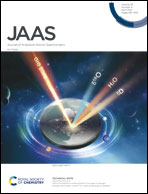Investigating the potential of tandem inductively coupled plasma mass spectrometry (ICP-MS/MS) for 41Ca determination in concrete
Abstract
Concrete is a common structural material used in nuclear reactors for biological shielding, containment buildings, and waste storage ponds. Calcium is a significant component of concrete, with neutron activation of stable 40Ca (96.94% abundance) leading to the production of 41Ca (half-life 1.002(17) × 105 years). The long half-life combined with the significant amount of concrete at nuclear facilities makes 41Ca a key radionuclide for characterisation of low and intermediate level waste, as well as for long-term waste monitoring. Measurement of 41Ca by inductively coupled plasma mass spectrometry (ICP-MS) is theoretically achievable, but has previously been prevented by multiple interferences, some of which cannot be removed by offline chemical separation. This study tests the potential of tandem ICP-MS/MS and its enhanced interference separation for the detection of 41Ca in concrete samples. The instrument setup was initially optimised using stable element standards, with a combination of NH3, H2 and He proving to be most effective, achieving an instrument detection limit of 0.32 Bq g−1 (0.099 ng g−1). The procedure was validated on several concrete samples, which required the optimisation of automated borate fusion sample digestion and four-stage chemical separation, with recoveries of 73–77%. Successful detection of 41Ca was achieved at activity concentrations down to 0.67 Bq g−1 (0.21 ng g−1) at 41Ca/40Ca ratios of 10−6–10−7. This represents the first known measurement of 41Ca using ICP-MS, and recommendations are made on how instrument capabilities can be further improved so that routine measurement can be realised.



 Please wait while we load your content...
Please wait while we load your content...